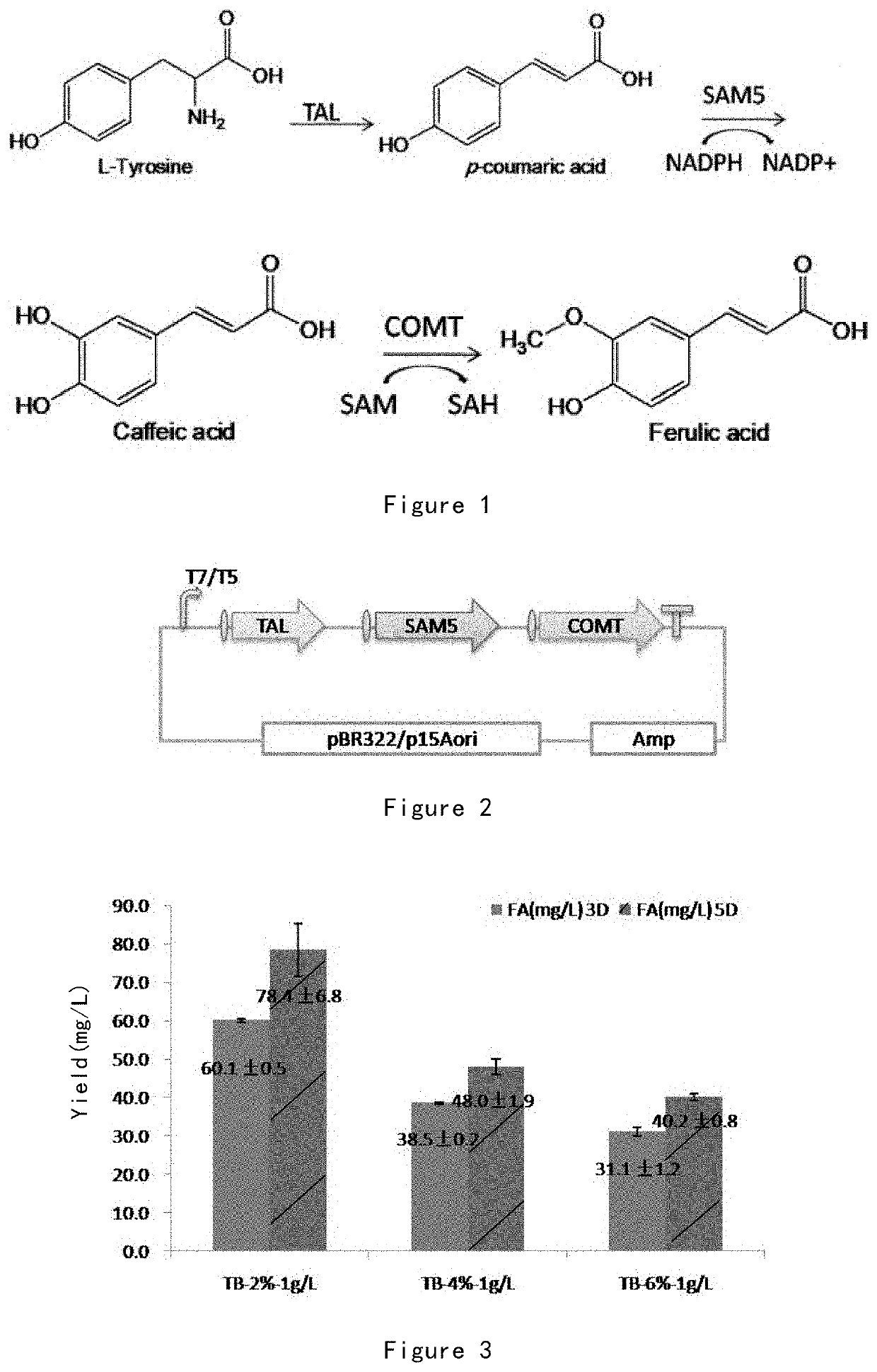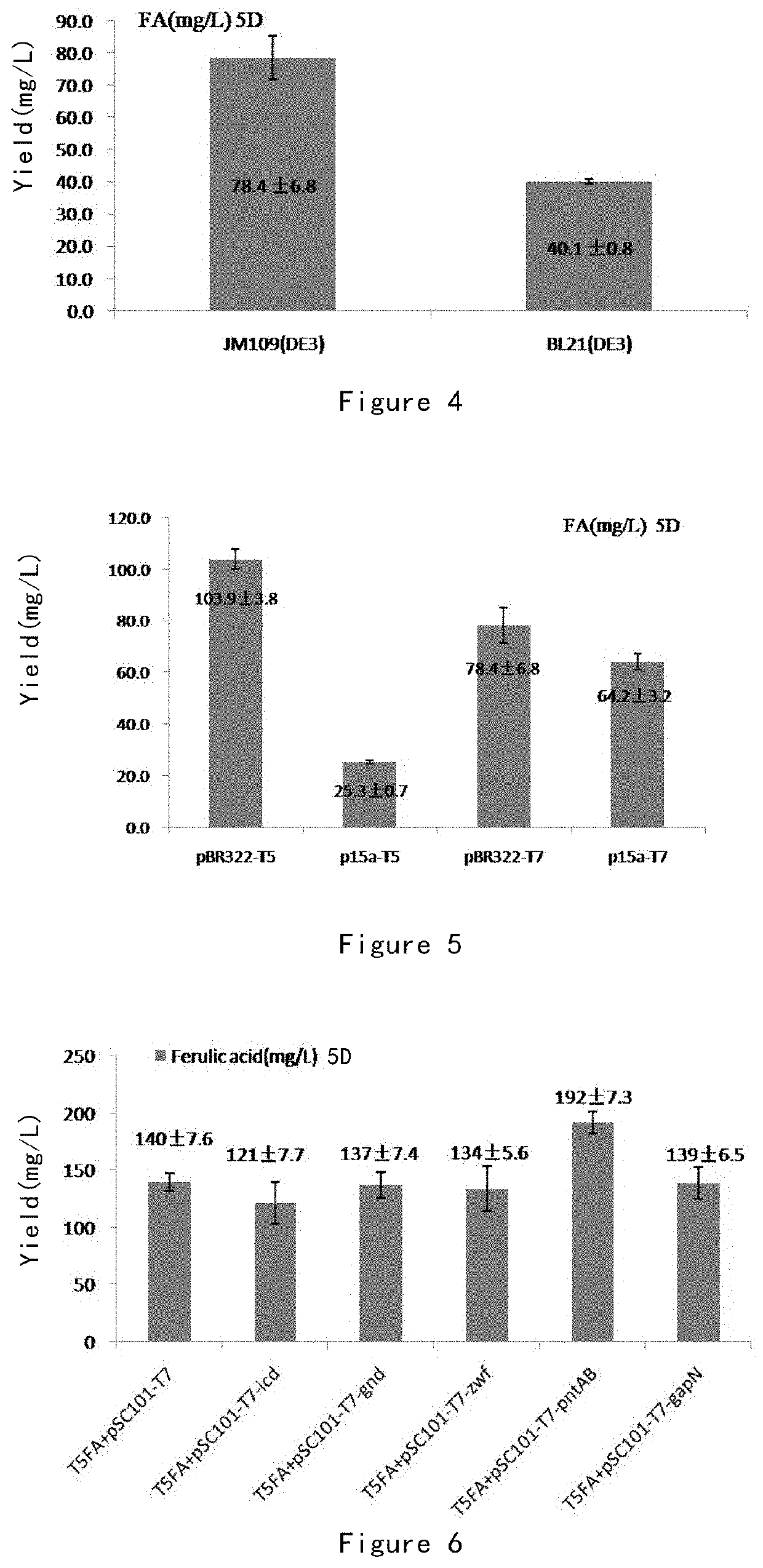Engineering Bacteria for Ferulic Acid Production, Preparation Method and Use Thereof
a technology of ferulic acid and engineering bacteria, which is applied in the field of recombinant cells for efficient synthesis of ferulic acid, can solve the problems of high cost, difficult production and high cost, and difficult separation of cis-ferulic acid
- Summary
- Abstract
- Description
- Claims
- Application Information
AI Technical Summary
Benefits of technology
Problems solved by technology
Method used
Image
Examples
example 1
ion and Optimization of Engineering Bacteria
[0106]In this Example, an engineering strain for ferulic acid production is constructed. The host strain is E. coli JM109 (DE3) or BL21 (DE3), which is transformed by plasmid(s) harboring the gene(s) of the ferulic acid biosynthetic pathway with tyrosine as a substrate.
[0107]The enzymes / genes used to construct the ferulic acid biosynthetic pathway gene expression cassette are shown in Table 2.
TABLE 2Enzyme / GeneSourceGenBank Access No.Tyrosine ammonia-Rhodobacter GenBank_CP033447.1lyase, TAL; EC sphaeroides4.3.1.234-coumarate-3-Saccharothrix GenBank_HE804045.1hydroxylase espanaensis(β-Coumaric acid 3-hydroxylase, SAM5; EC 1.14.14.9)Caffeic acid O-Triticum GenBank_EF413031.1methytransferase, aestivumCOMT; EC 2.1.1.68
[0108]The plasmid construction method includes the following steps:
[0109]1.1 Ferulic acid synthesis pathway genes linked into one operon
[0110](1) Tyrosine ammonia-lyase gene (TAL, 1575 bp) synthesized by double digestion of Nco I...
example 2
ptimization
[0119](1) Construction of Plasmid pCL1920-T7 Operator (T7 Operon)
[0120]Using plasmids pCL1920 (Biovector, spectinomycin resistance, SC101 replicon) as templates, vector fragments were amplified with primer pCL1920VF / pCL1920VR. Using plasmid pET28a (kanamycin resistance, pBR322 replicon) as templates, the inserted fragments were amplified with primer T7 operatorF / T7 operatorR. The plasmid pCL1920-T7 operator was constructed by infusion method.
[0121](2) Construction of Optimized Plasmid
[0122]Zwf (NcoI-HindIII), gnd (NdeI-HindIII), and icd (NcoI-HindIII) were amplified using E. coli MG1655 (Ec) genome as template, digested with corresponding restriction endonucleases and linked into pET28a vectors by T4 ligase. Then, the inserted fragments were obtained by double digestion of the above vectors with XbaI-HindIII. The vector fragments were obtained by double digestion of pCL1920-T7 operator with XbaI-HindIII. Plasmids pCL1920-T7-Ecicd, pCL1920-T7-Ecgnd, and pCL1920-T7-Eczwf we...
example 3
tion of Carbon Source Amount
[0125]This Example used glycerol as the carbon source to study the amount of ferulic acid produced by different amounts of carbon source.
[0126]JM109 (DE3) strain transformed with pBR322-T7-tal-sam5-comt was tested for three treatment groups of 2% (V / V), 4% (V / V) and 6% (V / V) glycerol.
[0127]Monoclonal strain was selected and inoculated into 2 mL LB (10 ml small test tube) containing antibiotics, cultured overnight (12 h). The cultured bacteria were trans-inoculated by 5% into TB medium added with antibiotics, 0.1 mm IPTG and 1 g / L L-tyrosine, and fermented at 28° C. and 250 rpm, then sampled (1 ml) at day 3 and day 5. Samples were extracted twice with 1V ethyl acetate, re-suspended in methanol, and FA was detected by HPLC at 310 nm.
[0128]The results are shown in FIG. 3. Unexpectedly, it is not that the higher the amount of carbon source, the better. The yield is significantly the highest with 2% glycerol.
PUM
| Property | Measurement | Unit |
|---|---|---|
| volume | aaaaa | aaaaa |
| p-coumaric acid | aaaaa | aaaaa |
| nucleic acid | aaaaa | aaaaa |
Abstract
Description
Claims
Application Information
 Login to View More
Login to View More - R&D
- Intellectual Property
- Life Sciences
- Materials
- Tech Scout
- Unparalleled Data Quality
- Higher Quality Content
- 60% Fewer Hallucinations
Browse by: Latest US Patents, China's latest patents, Technical Efficacy Thesaurus, Application Domain, Technology Topic, Popular Technical Reports.
© 2025 PatSnap. All rights reserved.Legal|Privacy policy|Modern Slavery Act Transparency Statement|Sitemap|About US| Contact US: help@patsnap.com


